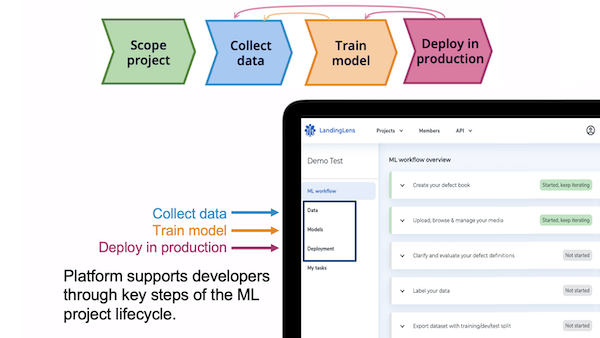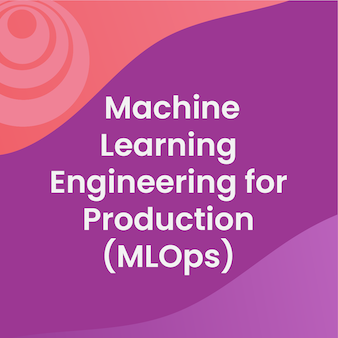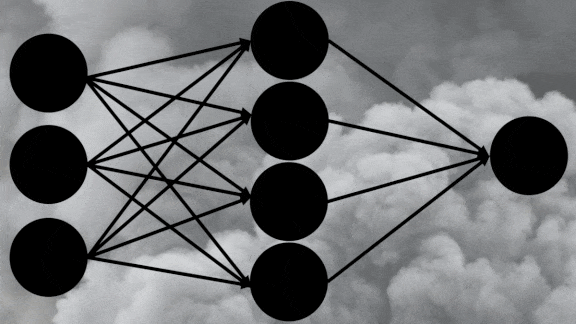Dear friends,
It can take 6 to 24 months to bring a machine learning project from concept to deployment, but a specialized development platform can make things go much faster.
It used to take me months to deploy a model. With a no-code platform, I can train a RetinaNet demo, carry out error analysis, use a data-centric approach to clean up inconsistent data, retrain, and deploy to an edge device — all in 60 minutes. I get a thrill every time I go through the machine learning project lifecycle so quickly.
Keep learning! Andrew
News
RobocodersLanguage models are starting to take on programming work. What’s new: SourceAI uses GPT-3 to translate plain-English requests into computer code in 40 programming languages. The French startup is one of several companies that use AI to ease coding, according to Wired. How it works: Companies have trained language models to anticipate programmers’ needs.
Behind the news: Other companies are also using machine learning to increase coders’ productivity and sniff out bugs.
Why it matters: In the hands of a skilled programmer, such tools can save time, freeing up brainpower for more complex tasks. In the hands of the newbie, they make it possible to create applications with little experience and — with diligent attention — gain skills more quickly. We’re thinking: No AI system should replace a sacred rite of passage for neophyte coders: print(“Hello World!”).
Banking on Computer VisionAI-powered surveillance is becoming a staple in U.S. banks. What’s new: Several banks are using cameras equipped with computer vision to bolster security and boost employee productivity, according to Reuters. What’s up: The companies have a variety of aims and approaches.
Behind the news: The latest moves build on earlier attempts by financial institutions to take advantage of image recognition technology.
Why it matters: If banks can get regulators and consumers to accept AI-assisted surveillance in branch offices, it will add momentum to wider adoption of the technology. We’re thinking: Many of these use cases seems more like surveillance than security. Without sufficient sensitivity to public concerns, such efforts is likely to inspire backlash. Organizations that aim to take advantage of this technology: Tread cautiously.
A MESSAGE FROM DEEPLEARNING.AI
Building a career in deep learning? Training models is important, but you also need to know production engineering. That’s why we’re launching Machine Learning Engineering for Production (MLOps) on May 12, 2021. Sign up to learn about upcoming launches
Greener Machine LearningA new study suggests tactics for machine learning engineers to cut their carbon emissions. What’s new: Led by David Patterson, researchers at Google and UC Berkeley found that AI developers can shrink a model’s carbon footprint a thousand-fold by streamlining architecture, upgrading hardware, and using efficient data centers. What they did: The authors examined the total energy used and carbon emitted by five NLP models: GPT-3, GShard, Meena, Switch Transformer, and T5. They reported separate figures for training and inference. Generally, they found that inference consumes more energy than training.
Behind the news: The authors joined the Allen Institute and others in calling for greener AI. To this end, MLCommons, the organization behind the MLPerf benchmark, recently introduced new tools to measure a model’s energy consumption alongside traditional performance metrics. Why it matters: Training and deploying a large model can emit five times more carbon dioxide than a single car over the course of its lifetime. As AI becomes more widespread, energy efficiency becomes ever more important. We’re thinking: There are bigger levers for reducing carbon emissions, such as transitioning the world away from coal power. Still, as a leading-edge industry, AI has an important role in building a the green future.
3D Object FactoryIn the open-ended video game Minecraft, players extract blocks of virtual materials from a 3D environment to assemble objects of their own design, from trees to cathedrals. Researchers trained neural networks to generate these structures. What’s new: Shyam Sudhakaran and researchers at University of Copenhagen, University of York, and Shanghai University used a neural cellular automaton algorithm to construct 3D objects. The work demonstrates the potential for such algorithms to generate structures in three dimensions, as typically they’re limited to two. Key insight: A cellular automaton generates complex patterns on a 2D grid by changing each cell’s state iteratively based on simple rules that depend on the states of its neighbors. A neural cellular automaton updates cells depending on the output of a neural network and the states of neighboring cells. Using 3D convolutions enables a neural cellular automaton to generate patterns in 3D. How it works: The authors trained several 3D convolutional neural networks to reproduce structures found on the community website Planet Minecraft. Each different structure required its own model. The structures comprised 50 block types mostly corresponding to materials (stone, glass, metals, and so on), including piston blocks that push or pull adjacent blocks to produce animated objects. The system spawned block types directly without needing to virtually mine them out of the virtual ground.
Results: The authors reported few quantitative results. However, the trained models grew static structures like castles, temples, and apartments that appear to be accurate inside and out. One model learned to grow an animated caterpillar. Why it matters: Cellular automata may have certain benefits. For instance, if part of the resulting structure is destroyed, the automaton can use what’s left to regenerate the missing part. This approach can produce resilient digital 3D structures with no human intervention after the first step. We’re thinking: Machine learning engineers looking for an excuse to play Minecraft need look no further!
Work With Andrew Ng
Machine Learning Instructor (US): FourthBrain is looking for a Machine Learning Instructor to work closely with the Curriculum Development Director at FourthBrain to leverage their technical skills in ML to manage a cohort of students in a part-time ML training program. Apply Here
Subscribe and view previous issues here.
Thoughts, suggestions, feedback? Please send to thebatch@deeplearning.ai. Avoid our newsletter ending up in your spam folder by adding our email address to your contacts list.
|






